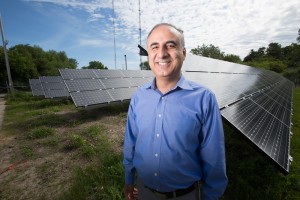It wasn’t a natural disaster or high demand that caused an electrical blackout in the northeastern United States in summer 2003. A high-voltage power line in Ohio brushed against overgrown trees, causing it to shut down, and touching off a domino effect of disabled lines.
For the next two days, 50 million people in eight states were left without power. But a technology being perfected at the University of Wisconsin–Milwaukee (UWM), called a microgrid, will keep that from happening again.
Microgrids are free-standing power sources that integrate disparate energy-generating sources, store the energy and then distribute it uninterrupted to a limited surrounding area during power outages.
“Any place where large numbers of people congregate – military bases, factories, sports arenas or even Disney World – would be unaffected by a blackout if there is a microgrid in place,” said Vijay Bhavaraju, principal engineer in power system technologies at Eaton Corporation.
Eaton is one of six Milwaukee companies working with UWM Professor Adel Nasiri to advance microgrid technology, addressing the obstacles that have so far kept it from the commercial market where it is projected to generate revenues of $3 billion by 2017.
“This one in Milwaukee will be the state-of-the-art microgrid testbed in the country,” Nasiri explained. “We can use it in conducting research for federal projects, and for testing with private companies. It will accelerate what we can do together with industry.”
While microgrids can serve as energy islands, Nasiri’s testbed has another important benefit: It can integrate energy from diverse sources – like solar, wind and batteries – into the nation’s distribution system for electricity, called the central grid. That means eco-minded energy consumers won’t have to put solar cells in their backyards in order to have access to green energy.
The timing is right. The cost of obtaining renewable energy is dropping. But because renewables generate and distribute energy differently than power plants, the transfer of these added sources isn’t compatible with the nation’s grid.
In order to augment the grid, the “added” energy sources must conform to the way the existing grid distributes electricity.
When dispatching energy from coal-burning power plants or hydroelectric plants, the grid adjusts the output amount to match user demand. Energy coming from renewable energy sources is not adjustable, however, and is difficult to store.
“By adding multiple other sources, we will need to ‘smooth out’ the intermittent power that renewables generate, in order to keep the output-demand in balance,” Nasiri said.
Wind turbines, for example, generate electricity only when the wind is blowing. But in most places, the wind blows more often at night when demand for electricity is low. Nasiri’s patented technology allows renewable energy produced when demand is low to be stored and then released when the demand is high.
Microgrids like the one Nasiri is building with industry partners will fix energy-compatibility problems, and ultimately help reduce emissions from fossil fuel-burning power plants by increasing use of renewables.
The energy sources in a microgrid vary in number and variety. Renewables could be included in a microgrid, but so could natural gas- and diesel-fueled generators.
UWM engineering students are working with Eaton on software that allows communication among the various energy sources, giving the microgrid the ability to customize the mix of energy sources in its “arsenal” in order to improve efficiency.
“For example, on a windy day you could eliminate the diesel portion of the microgrid,” said Eaton’s Bhavaraju. “You can tune the kind of output to the end user by scheduling when to turn one source on and another one off. So if we can manage the electricity sources, we could show up to 40 percent in fuel savings.”
UWM-industry collaboration
UWM’s microgrid testbed, funded in part by the Midwest Energy Research Consortium, an industrial-academic research coalition, will give regional companies a first look at the compatibility of their parts. Besides Eaton, other participating companies are Kohler, Rockwell Automation, LEM, Odyne and ZBB Energy Corp.
The U.S. Army is already developing microgrid technology to ensure power to military bases. Nasiri and Bhavaraju recently received funding to improve operations of a microgrid at Fort Sill, a base about 80 miles southwest of Oklahoma City.
Their objective was to identify how to orchestrate a seamless transfer of service when the microgrid is disconnected from the grid.
Their efforts resulted in creation of a new part, the controller, which enables that uninterrupted jump.
Working out the manipulation of energy needed to make microgrids safe and viable is a major undertaking. One of Nasiri’s remaining challenges is developing components that will streamline the complicated task of managing voltage and frequency.
Along the microgrid construction journey, UWM engineering students from Nasiri’s lab have participated in grant-funded research, such as the Fort Sill microgrid project. Eaton has hired a few UWM students part-time to focus on a specific feature, says Bhavaraju.
Of three UWM students assisting with the work at Fort Sill, Eaton recently hired two full time after graduation.
The participation of students is an asset to the work, added Bhavaraju. “It will be the students who will move the needle.”
By Laura L. Otto

